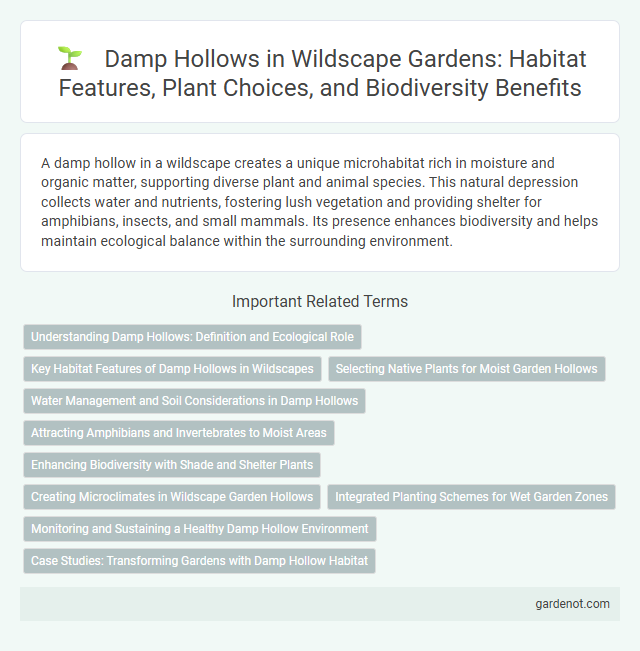A damp hollow in a wildscape creates a unique microhabitat rich in moisture and organic matter, supporting diverse plant and animal species. This natural depression collects water and nutrients, fostering lush vegetation and providing shelter for amphibians, insects, and small mammals. Its presence enhances biodiversity and helps maintain ecological balance within the surrounding environment.
Understanding Damp Hollows: Definition and Ecological Role
Damp hollows are low-lying depressions in wildscapes that retain moisture and create unique microhabitats supporting diverse flora and fauna. These areas play a crucial ecological role by maintaining soil humidity, providing breeding grounds for amphibians, and supporting moisture-loving plant species. Understanding the formation and function of damp hollows aids in conserving biodiversity and managing wetland ecosystems effectively.
Key Habitat Features of Damp Hollows in Wildscapes
Damp hollows in wildscapes provide essential microhabitats characterized by moist, nutrient-rich soil and shaded conditions, supporting diverse plant species such as ferns, mosses, and amphibious flora. These areas maintain high humidity and consistent moisture levels, creating ideal breeding grounds for amphibians, invertebrates, and moisture-dependent birds. The unique hydrology and organic matter accumulation in damp hollows enhance soil fertility and biodiversity, making them critical ecological niches within wildscapes.
Selecting Native Plants for Moist Garden Hollows
Damp hollows in wildscapes thrive with native plants such as ferns, sedges, and moisture-loving wildflowers like cardinal flower (Lobelia cardinalis) and marsh marigold (Caltha palustris). These species are adapted to saturated soils and provide essential habitat and food sources for local wildlife. Choosing native plants for moist garden hollows enhances biodiversity and supports ecosystem resilience by conserving water and preventing erosion.
Water Management and Soil Considerations in Damp Hollows
Effective water management in damp hollows involves maintaining optimal moisture levels to support diverse wetland plant species while preventing waterlogging and soil erosion. Soil considerations include ensuring high organic matter content and proper drainage to sustain nutrient-rich, anaerobic conditions essential for specialized flora and fauna. Regular monitoring of water tables and soil pH helps preserve the delicate balance necessary for ecosystem stability in these wet habitats.
Attracting Amphibians and Invertebrates to Moist Areas
Damp hollow environments create ideal microhabitats by maintaining consistent moisture levels, attracting a diverse range of amphibians such as newts, frogs, and toads. These moist areas also support invertebrates like beetles, spiders, and terrestrial snails, which rely on humidity for survival and reproduction. Incorporating damp hollows into wildscapes enhances biodiversity by providing essential shelter and breeding grounds for moisture-dependent species.
Enhancing Biodiversity with Shade and Shelter Plants
Damp Hollow in Wildscape benefits significantly from the strategic planting of shade and shelter species, which create microhabitats essential for diverse flora and fauna. Native trees and shrubs, such as alder and willow, improve soil moisture retention and provide refuge for amphibians, birds, and beneficial insects. These plants enhance ecosystem resilience, promoting a balanced and thriving biodiversity within the damp hollow environment.
Creating Microclimates in Wildscape Garden Hollows
Damp hollows in wildscape gardens serve as natural microclimates, fostering diverse plant and animal life by maintaining higher moisture levels and cooler temperatures than surrounding areas. These microhabitats support moisture-loving species such as ferns, mosses, amphibians, and various invertebrates, enhancing biodiversity in the garden ecosystem. Designing and preserving damp hollows promotes ecological balance and resilience, contributing to sustainable wildscape garden management.
Integrated Planting Schemes for Wet Garden Zones
Damp hollow areas in wildscapes benefit from integrated planting schemes that prioritize moisture-loving native species such as sedges, rushes, and marsh marigolds, promoting biodiversity and natural water filtration. Strategic layering of plants enhances soil stability while providing habitat for amphibians and pollinators in wet garden zones. Incorporating a mix of emergent, marginal, and submerged vegetation optimizes ecological function and aesthetic appeal in damp hollows.
Monitoring and Sustaining a Healthy Damp Hollow Environment
Effective monitoring of damp hollow environments involves regular assessments of moisture levels, temperature, and biodiversity indicators to ensure optimal habitat conditions for moisture-dependent species. Utilizing tools such as data loggers and environmental sensors helps track changes, enabling early detection of potential threats like fungal overgrowth or invasive species. Sustaining a healthy damp hollow requires adaptive management practices, including controlled humidity regulation and habitat restoration efforts, to maintain ecological balance and support native flora and fauna.
Case Studies: Transforming Gardens with Damp Hollow Habitat
Damp Hollow habitat restoration has transformed numerous gardens by introducing moisture-retentive soil layers and native wetland plants, promoting biodiversity and enhancing water filtration. Case studies reveal that integrating species such as marsh marigold and sedges significantly improves local amphibian populations and pollinator activity. These sustainable garden designs exemplify how Damp Hollow habitats can mitigate runoff while creating vibrant, ecologically balanced spaces.
Damp hollow Infographic

 gardenot.com
gardenot.com